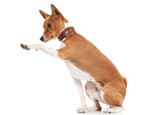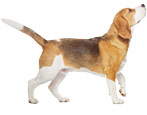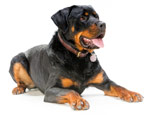How much food should you give your dogs a day?

Each owner cares about the health of his pet, especially when it comes to a growing puppy, the body of an adult dog or the health of an aging animal. Feeding is an integral part of the healthy development and proper functioning of all organs of the animal, therefore it is very important to pay special attention to compiling the correct diet, taking into account the amount of feed consumed.
It is sometimes difficult to determine the norm, but it is imperative to do it., because malnutrition and overeating can cause major health problems for the animal. Let's take a closer look at how much food should be fed to the animal's body every day and how to maintain a balance.

How to calculate the daily allowance for weight?
The daily food intake for an animal will be determined by a combination of several factors. For example, based on the age of the dog and its size. This is also influenced by the characteristics of the reproductive system, since castrated and neutered animals experience a much greater appetite and hunger, and therefore need a special diet. Let us consider in more detail all the features of determining the daily portion of dog food.

For puppies
It's no secret that puppies are more voracious than adult dogs, so it is especially important to correctly calculate the correct dosage when feeding them.
The first complementary feeding with dry food should be started from 1-1.5 months, gradually introducing the product into the diet and reducing the proportion of mother's milk. From 1.5 to 3 months, the puppy should already completely switch to independent feeding, and during this period the daily feed rate should be equal to the double rate of an adult animal of the same breed.As the puppy grows, it needs a lot more nutrients.
For babies aged 3 to 6 months, portions should become smaller and instead of double the volume per day, one and a half will be enough. The main thing is to take measurements regularly in order to make sure that the puppy's weight is being added correctly and without excess. Particular attention should be paid to 4-month-old animals, since during this period there is a sharp jump in their growth.

From 6 months to 1 year, portions should also be gradually reduced. The approximate daily dosage during this period is 1.25 times the norm for an adult dog. And starting from the age of one, the daily daily portion should be calculated solely on the basis of the breed characteristics and weight category of the dog.
It is worth noting that puppies are fed hourly in small portions. So the animal will feel full throughout the day, and the food will gradually enter the body, without stressing the stomach and digestive system.

For adult dogs by weight
Serving Size for Adult Dogs is determined not only by the weight category, but also by the degree of activity of the animal.
- For a two-kilogram animal leading an active lifestyle, 60 grams of food will be enough, and even 30 grams will be enough for a four-legged couch potato.
- Individuals whose weight reaches 5 kilograms, with active walking, a portion weighing 100 grams is needed, while an animal with a calm lifestyle will only need 60 grams.
- 160 grams is the daily daily portion of a 10-kilogram animal leading an active lifestyle. But for a sluggard of the same weight category, 120 grams of dry food will be enough.
- For an active animal weighing 20 kilograms, the average daily portion weight should be approximately 300 grams, and for a passive pet - 180-200 grams.
- A dog weighing 30 kilograms needs a good portion of food - 400 grams, provided that the pet is regularly subjected to physical activity. In their absence, 250 grams of feed will be enough.
- For a 40 kg dog, the serving size should be carefully selected in accordance with his lifestyle: for active dogs - 450-480 grams, for passive dogs - about 300 grams.
- 50-60 kilograms is a fairly large weight for a dog. Usually, such pets are large, strong, but not very mobile, therefore, when calculating the daily diet, it is necessary to take into account training and training. For animals exercising more than 60 minutes a day - 550-650 grams of feed, for those whose training lasts less than 1 hour - 350-400 grams.
It should be borne in mind that these are average data and each dry food manufacturer indicates on the packaging the recommended serving sizes for both one-time feeding and the daily allowance.


During pregnancy and lactation
During pregnancy, the dog's body needs special support and a special feeding regime, since the animal's strength is spent not only on the natural process of life, but also on bearing offspring.
If the owners have the opportunity, it is recommended to purchase special food for animals in the position, but if this is not possible, then the daily ration should be slightly larger than with normal feeding.
As a rule, the amount of food is determined based on the activity of the dog, and also taking into account the fact that a pregnant dog should consume 30-50% more food than a regular animal.

As for the lactation period, here you need to treat the diet with special attention. Since at this time the dog's body is most stressed, and most of the nutrients and vitamins are spent on feeding the puppies, it is necessary to ensure that it has free access to food in any quantity.
Overeating in this case is excluded, since the animal will eat based on the needs of the body.

Dosage by brand
Many manufacturers set their own daily dosage for dog food.Most often, detailed instructions are located on the back of the package, and you can measure the required amount using a measuring cup or a special measuring spoon. If there is no such tool, then you can use a regular tablespoon, which, on average, holds 20 grams of dry food without a slide.
Let us consider in more detail the dosage of feed from various manufacturers in the form of a table.
Pedigree - economy class food, which veterinarians do not recommend feeding pets, but some still prefer it.
For puppies.
Puppy age (month) | 2-4 | 5-6 | 7-10 | 11-12 |
Puppy weight (kilograms) | Daily feeding rate in grams | |||
1-2 | 65 | 45 | 40 | - |
3-4 | 150 | 100 | 90 | - |
5-9 | 210 | 160 | 125 | - |
10-14 | 350 | 270 | 245 | 190 |
15-19 | 650 | 455 | 360 | 260 |
20 | 800 | 615 | - | - |
Number of feedings | 4 | 4 | 3 | 2 |


For adult dogs of all breeds, the feed dosage is determined as follows.
Dog weight in kilograms | 5-9 | 10-14 | 15-19 | 20-24 | 25-34 | 35-44 | 45-54 | 55 and more |
Feed weight in grams | 90 | 150 | 210 | 255 | 300 | 385 | 460 | 550 – 600 |


Purina one - a premium nutritional food line with a variety of options. There are divisions by breed, and the instructions indicate how to feed the animal to maintain its weight or in the case of a diet.
Dosage of food for small and medium breeds of dogs.
Animal weight in kilograms | Feed weight in grams | |
To maintain weight | When dieting | |
1-5 | 45-125 | 35-100 |
5-10 | 125-200 | 100-160 |
10 and more | 200 + 10 g for each additional kg of weight | 160 (+ 10) |

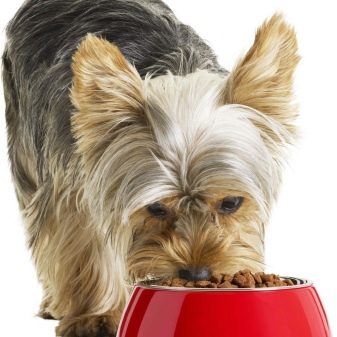
Daily food intake for large dog breeds.
Dog weight in kilograms | Feed weight in grams | |
For active dogs | For passive dogs | |
20-35 | 380-480 | 285-360 |
35-45 | 480-565 | 360-425 |
45-60 | 565-685 | 425-515 |
60-70 | 685-760 | 515-570 |
70-90 | 760-900 | 570-565 |


Alma nature - high-quality food of the holistic class, which has recently become very popular, since it contains only natural ingredients that are useful for the animal's body.
Daily norms for puppies of different breeds.
Puppy weight in kilograms | Puppy age by month | |||||
2-4 | 4-6 | 6-8 | 8-10 | 10-11 | 12 | |
Feed portion weight in grams | ||||||
Up to 2 | 40-50 | 50-60 | 55-65 | 55-65 | 50-60 | 40-50 |
3-4 | 60-70 | 80-90 | 90-100 | 90-100 | 80-90 | 70-80 |
5-6 | 80-90 | 90-100 | 110-120 | 110-130 | 90-100 | 80-90 |
7-8 | 90-110 | 110-130 | 130-140 | 120-140 | 110-130 | 90-110 |
9-10 | 130-140 | 140150 | 150-170 | 150-170 | 140-160 | 120-140 |


Daily Value for Small Breed Dogs.
Animal weight in kilograms | 1-2 | 2-4 | 4-6 | 6-8 | 8-10 |
Serving weight in grams | 35-45 | 45-65 | 65-80 | 80-110 | 105-120 |
Daily dosage for medium breed dogs.
Dog weight in kilograms | 4-6 | 6-8 | 8-10 | 10-12 | 12-15 |
Serving weight in grams | 55-120 | 120-265 | 260-400 | 410-500 | More than 500 |
Daily norms for animals of large breeds.
Dog weight in kilograms | 20-40 | 40-50 | More than 50 |
Serving weight in grams | 250-380 | 380-500 | More than 500 |

How many times a day to feed?
In addition to the correct daily feed dosage, it is also necessary to determine the number of feedings per day. It is very important to maintain a balance in this matter, since the dog should not be hungry during the day, as this can directly affect not only its health, but also behavioral responses.
When weaning a puppy from its mother and introducing food into its diet, it is necessary to break the feeding process into 6 meals in small portions. So food will be better digested, and useful trace elements and vitamins can be absorbed to a greater extent in a growing body.
By 2-3 months, the number of meals should be reduced to 5, and by the end of 6 months of the puppy's life - up to 4 times a day. In the period from 6 months to a year, it will also be necessary to reduce the number of meals, first to 3, and later to 2 times a day.

In some cases, the owners leave the dog on 3 meals a day, because with fewer meals and a longer break between them, the animal will experience physical discomfort.
It should also be borne in mind that for 1 meal, the animal must eat the entire food offered to him. If it remains in the bowl, the portion size must be reduced as the dog is being fed with less food.
Special attention should be paid to the issue of feeding pregnant dogs. As mentioned earlier, during this period, the animal's body needs special support, therefore it is recommended to gradually increase the number of feedings, first to 3, and then to 4 times a day.
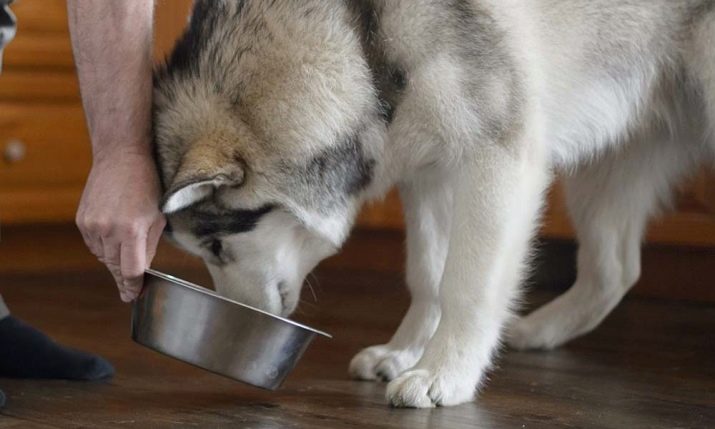
How do you know if your dog is full?
It's no secret that many dogs can have a dull feeling of satiety, so they tend to eat any amount of food out of control. Naturally, this negatively affects the health of the animal, so it is especially important for the owner to monitor the dog's nutrition and learn to determine that the animal is full and feeding can be stopped.
The first and sure sign that your dog is full is when he stops eating. The animal finishes eating and simply walks away from the bowl, without begging the owner for additives or food from the table. This is quite rare, since many animals are prone to begging for sweets.
If, after the animal has been denied the supplement, it resentfully leaves for its place - you can be calm, the dog is full and just tries to snatch a few more tidbits. But if during the day she constantly walks around her bowl, sniffs it and tries to lick an empty bowl, you should think about increasing the portion or checking the health of your pet's gastrointestinal tract.
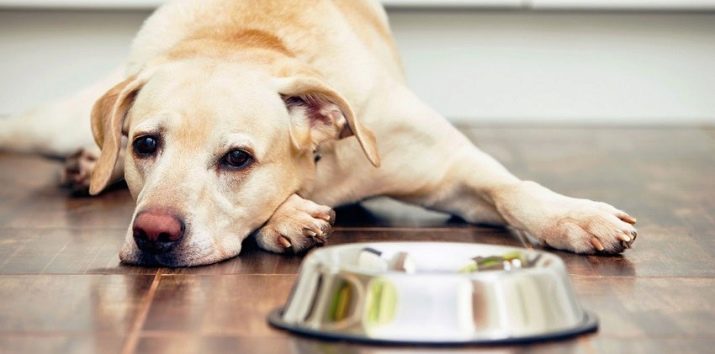
If the dog begins to openly play with food during the meal, push it out of the bowl with its nose or simply scatter it on the floor, this may indicate that the animal is full, but out of greed does not want to leave anything in the bowl, because it knows that the owners will remove it. leftovers.
Another sign of satiety can be that the dog begins to hide the remains of food. Such actions are typical for hunting dogs, because they try to leave for later what they could not eat at one meal.
When feeding puppies, determining satiety can become a problem, since until the age of one year, the animal can eat uncontrollably in any quantities. Therefore, in this case, it is recommended to adhere to the systemic nutrition, give the animal a rate corresponding to its weight and age, and also take into account the correct number of meals, without reacting to the puppy's attempts to ask for a supplement.

For how many times a day and how much food to give the dog, see the next video.



